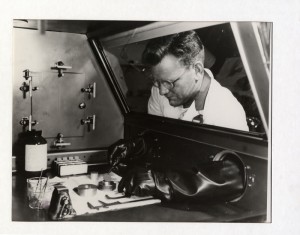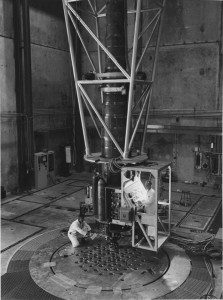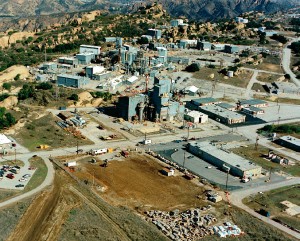 The Santa Susana Field Laboratory has a well-documented history of problems since it opened in 1948. Rocketdyne is contaminated by a wide variety of radionuclides, PCBs, dioxins, and heavy metals in a witches’ brew of deadly toxins that have fouled the soil, air, surface runoff and groundwater.
The Santa Susana Field Laboratory has a well-documented history of problems since it opened in 1948. Rocketdyne is contaminated by a wide variety of radionuclides, PCBs, dioxins, and heavy metals in a witches’ brew of deadly toxins that have fouled the soil, air, surface runoff and groundwater.
“Past site operations have resulted in soil and groundwater contamination,†according to the U.S. Environmental Protection Agency. “Primary chemical contaminants include a variety of radionuclides, trichloroethylene (TCE), perchloroethylene (PCE), metals, and petroleum hydrocarbons… Radionuclides associated with ETEC nuclear operations include tritium, plutonium-238, plutonium-239, iodine-131, strontium-90, cesium-137, cobalt-60, thorium-228, and uranium-235.â€
In July of 1959, an experimental sodium-cooled nuclear reactor partially melted down at the site after a “power excursion” in which power ran out of control and over days of radiation readings, which went off-scale. A third of its fuel experienced melting, and an unknown amount of radioactive material was pumped from the reactor, which had no containment structure, into the environment.
That partial meltdown was among a series of disasters to visit the 16 nuclear reactors and nuclear critical facilities that operated on the site from the mid-1950s to the ’80s. In 1964, a reactor designed for space also suffered damage to 80% of its fuel. A fuel rod, covered with sodium, exploded when cleansed with water in a “wash cell†a month before the SRe partial meltdown. Subsequently, a leach field became contaminated with a high amount of radioactive strontium 90 and was left undiscovered for 14 years before being dug up and hauled away to a waste dump.
Strontium 90 is a radioactive isotope with a half-life of 28.8 years, meaning that it halves itself though ionization again and again during that time cycle. As a rule of thumb, twenty times the half-life of a radionuclide is how long it will take to essentially completely decay. That means any strontium 90 released during the July 1959 partial meltdown will be gone in 2259.
Strontium 90 is a calcium mimicker meaning that it is taken up in our bones and teeth where it continues to radiate, possibly causing cancer, for our entire lives. “When people ingest Sr-90, about 70-80% of it passes through the body,†says the U.S. EPA. “Virtually all of the remaining 20-30% that is absorbed is deposited in the bone. About 1% is distributed among the blood volume, extracellular fluid, soft tissue, and surface of the bone, where it may stay and decay or be excreted.â€
This deadly radionuclide is linked to bone cancer, cancer of the soft tissue near the bone, and leukemia. It is often found with cesium 137, another man-made radionuclide of special concern at SSFL. Recently, cesium 137 was found in an outfall outside of Area IV at SSFL which shows that radiation does not stop at man-made boundaries. This discovery of the radionuclide has complicated removing the source soil contamination that is sending toxins down into the properties abutting the site.
“Radioactive cesium-137 is produced when uranium and plutonium absorb neutrons and undergo fission,†according to the U.S. EPA. “Examples of the uses of this process are nuclear reactors and nuclear weapons. The splitting of uranium and plutonium in fission creates numerous fission products. Cesium-137 is one of the more well-known fission products.†It is a potent radionuclide, meaning that it ionizes a lot, and has a half-life of 30 years.
“Like all radionuclides, exposure to radiation from cesium-137 results in increased risk of cancer,†says the U.S. EPA. “Exposure to waste materials, from contaminated sites, or from nuclear accidents can result in cancer risks much higher than typical environmental exposures.â€
People interested in making SSFL some sort of park or open space open to the public may be especially concerned by the findings of elevated cesium 137 at Rocketdyne. This is what the EPA has to say about exposure to this deadly substance:
“People may also be exposed from contaminated sites:
• Walking on cesium-137 contaminated soil could result in external exposure to gamma radiation. Leaving the contaminated area would prevent additional exposure.
• Coming in contact with waste materials at contaminated sites could also result in external exposure to gamma radiation. Leaving the area would also end the exposure.
• If cesium-137 contaminated soil becomes air-borne as dust, breathing the dust would result in internal exposure. Because the radiation emitting material is then in the body, leaving the site would not end the exposure.
• Drinking cesium-137 contaminated water, would also place the cesium-137 inside the body, where it would expose living tissue to gamma and beta radiation.â€
 Presently, the U.S. EPA is conducting an extensive soil survey to check for radioactive contamination in Area IV of the lab where the nuclear work was performed. Once we can be assured that SSFL is remediated to the standards demanded by law, SB-990, a law Boeing is challenging, only then can we be confident that having our kids running around the place, having picnics and playing with our pets at this scenic place will be safe.
Presently, the U.S. EPA is conducting an extensive soil survey to check for radioactive contamination in Area IV of the lab where the nuclear work was performed. Once we can be assured that SSFL is remediated to the standards demanded by law, SB-990, a law Boeing is challenging, only then can we be confident that having our kids running around the place, having picnics and playing with our pets at this scenic place will be safe.
That will be quite a task, as evident from the April 2006 report from Committee to Bridge the Gap entitled, “Radioactive Contamination of Water at SSFL.â€
We must ensure that SSFL is cleaned up properly and that the health of our communities comes first.